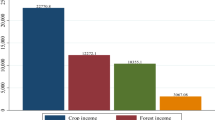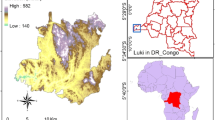Abstract
Empirical information regarding the role of homestead forests in household economy is essential in understanding the importance of these resources. Identification of the factors that affect homestead forest production and understanding forest owners' attitudes toward key forest management issues have great significance in making appropriate policy responses to manage these resources on a sustainable basis. In Bangladesh, homestead forests are claimed to play an important economic role in rural livelihoods, but no reliable quantitative information exists. This study was undertaken to investigate the role of homestead forests in the household economy, examine if forest production and income vary across landholding size classes, to explore the relationships of homestead forest production with species richness, education level, and household size, and to assess the attitude of homestead forest owners toward key forest management issues. Results show that homestead forests contribute 15.9% of the household income and generate 51.4 man-days of employment per household per year. Production of homestead forests significantly varies across landholding size classes. It was observed that forest production depends significantly on species richness of homestead forests and the education level of forest owners. However, no such relationship was found between forest production and household size. The study revealed that farming families depend more on forest income than nonfarming families. Attitudes of forest owners toward key forest management issues differ significantly across landholding size classes. For example, although the majority of the forest owners prefer fruit species to timber species, the percentage of respondents decreased as the landholding size class increased, while the opposite trend was observed for timber species. The findings of this study suggest that diversification of forests and extension of education amongst forest owners would improve forest production. Furthermore, forest policy should address the concerns of the forest owners in different landholding classes and focus on their specific requirements to enhance sustainable forest management.
Similar content being viewed by others
References
InstitutionalAuthorNameBangladesh Bureau of Statistics (1992) Bangladesh population census 1992, Zila: Bagerhat Government of Bangladesh Dhaka
InstitutionalAuthorNameBangladesh Bureau of Statistics (2000) 1998 Yearbook of agricultural statistics Government of Bangladesh Dhaka
InstitutionalAuthorNameBangladesh Bureau of Statistics (2003a) Census of agriculture 1996, Zila series Bagerhat Government of Bangladesh Dhaka
InstitutionalAuthorNameBangladesh Bureau of Statistics (2003b) Statistical year book 2001 Government of Bangladsh Dhaka
TW Bunderson AEL Wakeel ZA Saad I Hashim (1990) Agroforestry practices and potentials in western Sudan WW Budd I Ducchart LH Hardsesty F Steiner (Eds) Planning for agroforestry Elsevier Oxford 227–246
Douglas JJ (1981) Supply and demand of forest products and future development strategies, field document no. 2. UNDP/FAO/Planning Commission, Government of Bangladesh project BGD/78/010, Rome
Government of Bangladesh (1993) Forestry master plan (environment and landuse), Ministry of Environment and Forests, Dhaka
Government of Bangladesh (1995) Forest policy of 1994. Bangladesh Gazette, July 6, 1995, pp 241–244
Government of Bangladesh (1998) The fifth five year plan (1997–2002) Planning Commission, Ministry of Planning, Dhaka
M Loreau S Naeem P Inchausti J Bengtsson JP Grime A Hector DU Hooper MA Huston D Raffaelli B Schmid D Tilman DA Wardle (2001) ArticleTitleBiodiversity and ecosystem functioning: current knowledge and future changes Science 294 804–807 Occurrence Handle10.1126/science.1064088 Occurrence Handle1:CAS:528:DC%2BD3MXotVCitLw%3D Occurrence Handle11679658
VE Méndez R Lok E Somarriba (2001) ArticleTitleInterdisciplinary analysis of homegardens in Nicaragua: micro-zonation, plant use and socio-economic importance Agroforest Syst 51 85–96 Occurrence Handle10.1023/A:1010622430223
MA Momin MZ Abedin MR Amin QMS Islam MM Haque (1988) Existing homestead plantation and household fuel use pattern in the flood prone Tangail region of Bangladesh MZ Abedin CK Lai MO Ali (Eds) Homestead plantation and agroforestry in Bangladesh Bangladesh Agricultural Research Institute Dhaka 136–143
MR Motiur J Tsukamoto Y Furukawa Z Shibayama I Kawata (2005) ArticleTitleQuantitative stand structure of woody components of homestead forests and its implications on silvicultural management: a case study in Sylhet sadar upazila, Bangladesh J For Res 10 285–294 Occurrence Handle10.1007/s10310-004-0137-4
PKR Nair (1993) An introduction to agroforestry Kluwer Dordrecht
Singh CD (2000) Valuation and evaluation of trees outside of the forest (TOF) of Bangladesh. Draft paper for a regional study for Asia and Pacific in contribution to the forest resource assessment (FRA) 2000. FAO, Rome
O Soemarwoto (1987) Homegardens: a traditional agroforestry system with promising future HA Steppler PKR Nair (Eds) A decade of development ICRAF Nairobi 157–170
Author information
Authors and Affiliations
Corresponding author
About this article
Cite this article
Motiur, R., Furukawa, Y., Kawata, I. et al. Role of homestead forests in household economy and factors affecting forest production: a case study in southwest Bangladesh. J For Res 11, 89–97 (2006). https://doi.org/10.1007/s10310-005-0191-6
Received:
Accepted:
Issue Date:
DOI: https://doi.org/10.1007/s10310-005-0191-6




